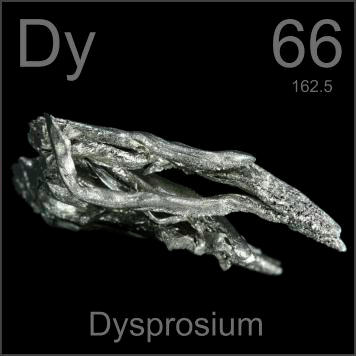Dysprosium is a rare-earth element with a lustrous and silvery appearance. Like most other rare-earth metals, it belongs to the Lanthanide series. Its name was derived from the Greek word dysprositos which can be translated as hard to get. Dysprosium was discovered in 1886 by a scientist known as Paul Emile Lecoq de Boisbaudran. However, it was not until 1905 that Georges Urbain first isolated it.

This rare-earth element has seven isotopes. The isotopes have a mass number of 154, 156, 158, 160, 161, 162, 163, and 164. However, the most abundant isotope has a mass number of 164 and is represented as 164Dy, while the least abundant isotope has a mass number of 156 and is represented as 156Dy.
China produces a good ninety-nine percent of all dysprosium produced every year. Other countries that produce dysprosium include the USA, Australia, Russia, and India. It is most commonly obtained from monazite sand. It can also be obtained from gadolinite, euxenite, polycrase, and fergusonite. Ion exchange and floatation processes are used to isolate dysprosium.
Properties
Dysprosium has similar properties with some rare-earth elements. These properties are responsible for its classification as a rare-earth element. However, it also has some properties that differentiate it from other rare-earth elements and make it unique.
Like other elements, its periodicity is responsible for its properties. In the periodic table, dysprosium belongs to period 6, f-block. Also, it is solid at room temperature. Its melting point is 1680 K, and its boiling point is 2840 K.
It has a hexagonal and closely packed lattice system. It also has a very high magnetic strength. It is ferromagnetic under 87K- 90K, antiferromagnetic above 87-90 K, and paramagnetic at about 179K.

Its standard atomic weight is 162.5. Like most metals, its density varies with its state. When it is solid, its density is 8.54 g/cm3. However, when it is liquid, its density decreases to 8.37 g/cm3. Dysprosium is electropositive, and its oxidation state is +3. As regards its chemical properties, it tarnishes slowly in a humid atmosphere, it is highly reactive with halogens at temperatures above 473 K, and it is easily soluble in H2SO4.
Applications
Dysprosium is usually used in combination with other metals because it is difficult to isolate. What are the uses of dysprosium in the world today, and how do its various properties make it suitable for these uses?
Permanent Magnets
This is one of the most common applications of dysprosium. Dysprosium cannot be demagnetized at very high temperatures. This particular property makes it an excellent permanent magnet. The permanent magnets formed from dysprosium alloys can be used to manufacture electric cars and wind turbines generators.

Nuclear Reactors
Dysprosium is used in the manufacture of control rods used for nuclear reactors. This is because dysprosium can absorb many neutrons without undergoing fission. This property of dysprosium is its high neutron capture cross-section.
Data-storage Devices
Data storage devices such as hard disks, floppy disks, compact disks, and flash drives can be produced with dysprosium alloys.
Thin-Film Coating
Dysprosium sputtering targets and dysprosium evaporation materials are used in deposition processes including semiconductor deposition, chemical vapor deposition (CVD) and physical vapor deposition (PVD).
Ships
Dysprosium alloys can be used in ships’ sound navigation and ranging systems due to their magnetic property. Hence, dysprosium is relevant in the marine industry.
Magnetic Refrigerators
As mentioned earlier, dysprosium is paramagnetic at specific temperatures. This particular property makes it an ideal component of magnetic refrigerators. Magnetic refrigerators can reach very low temperatures.
Laser Devices
An alloy of vanadium and dysprosium can be used in making laser devices. Laser devices can be used in laser cutting, law enforcement, medicine, printers, and even communication.
Infrared Radiation
Alloys of dysprosium can be employed in infrared devices. Infrared devices can be used for night vision, astronomy, weather forecasting, communication, and even medicine.
Corrosion Resistance
Magnets made with dysprosium are more resistant to corrosion than most of their other counterparts. It is for this reason that it is sometimes used in place of Neodymium in the production of magnets.
Reinforcement
When dysprosium is used to manufacture nanofibers, these nanofibers are very strong. These nanofibers can, in turn, be used to reinforce other products.
Dosimeters
Dysprosium is used in the manufacture of dosimeters. A dosimeter is a device that is used to measure ionizing radiation.
Conclusion
Dysprosium is indeed hard to get. This makes it quite expensive compared to other rare-earth metals. However, its numerous uses make it a highly sought-after rare-earth element. It is needed in the marine, automobile, biomedical, and telecommunication industries, to name a few. In terms of toxicity, keep in mind that soluble dysprosium salts are slightly toxic when taken orally, but solid dysprosium is not toxic.
If you want to know more about rare earth elements, we would like to advise you to visit Stanford Advanced Materials (SAM) for more information.




